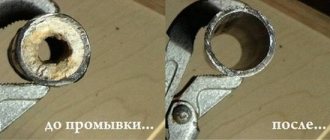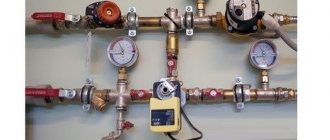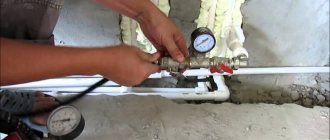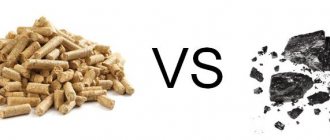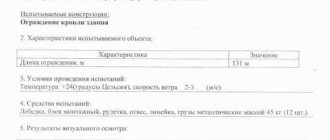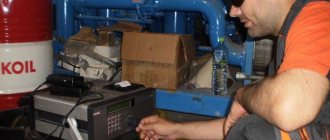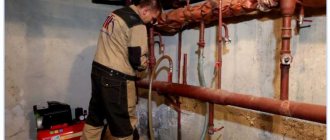Document year: 2019
Document group: Acts
Type of document: Act
Download formats: DOC, PDF
Test reports are drawn up in the form of document forms in which the results of testing the performance of mechanisms and equipment are recorded.
In today's article, we will consider in detail the testing of pipeline systems, sewerage systems, stairs and stepladders, roof fencing and fire tests.
Examples of drafting acts can be downloaded for free at the end of the article.
Hydraulic testing report for the heating and water supply pipeline system
Checks of heating and plumbing systems are carried out:
- when introducing new engineering communications;
- when reconstructing an existing one;
- during a routine check of the functioning of the system.
The step-by-step inspection and its results are recorded in the test report. The system is tested for tightness and strength in two ways, one of which is the hydraulic method: testing by using water with increased load. This method is suitable for indoor and outdoor systems (at temperatures not lower than +5C). The second method is pneumatic.
Both methods of acceptance testing are called pipe testing.
The results of the inspections are recorded in a report, the form of which is established by the Code of Rules for building codes and regulations. The template is presented in Appendix 1 to SANPin “External networks and structures of water supply and sewerage.” The presented form of the act is mandatory.
Procedure for drawing up the act:
1. Indication of general organizational information: city of compilation and date.
2. Representation of the members of the commission that carried out the pressure testing and acceptance of the pressure pipeline. Three parties become members:
| The company that installed the pipeline |
| Technical supervision representative from the customer |
| Operating company representative |
3. Below is information about the inspected object and a description of the pipeline (length, diameter, material of pipes and joints), information specified in the working documentation is given, and information about the pressure gauge used is given.
4. The section about the test and its results is completed.
5. In the section “Decision of the commission” there is a statement that the system is considered strong and airtight and this is signed by the members of the commission.
You can download the form for free at the end of the article.
Gas supply
Contract for hydraulic testing of the heating system No.
Info
Moscow "" 20 LLC "", represented by the General Director, acting on the basis of the Charter, hereinafter referred to as the "Customer", on the one hand, and LLC "", represented by the General Director, acting on the basis of the Charter, hereinafter referred to as the "Contractor" ", on the other hand, in the joint reference, the "Parties" have entered into this Agreement as follows: 1
Important
Subject of the Agreement 1.1 The Customer instructs and the Contractor undertakes to perform work to conduct a hydraulic test of the heating system of the building at the address: (hereinafter referred to as the Facility). https://www.youtube.com/embed/wyamZedWpzU
Certificate of pneumatic testing of pipelines
Pneumatic method: diagnosis by pumping the system with high pressure air. Often the method is used for external systems if the temperature on the thermometer is less than +5 Celsius.
The procedure for crimping pipes by pneumatic testing is given in the same SanPiN; the test report is drawn up in the required form, which is given in Appendix No. 3.
Requirements for drawing up test documentation:
- Filling in the name of the city and the date of compilation.
- Indication of the members of the commission (as in the hydraulic test, three parties are involved).
- Description of the pipeline: length, diameter, material of pipes and joints.
- Information about the pressure value: calculated value, to what value the pressure in the pipes was increased, final pressure, amount of reduction. The crimping time is indicated.
- In the “Decision of the Commission” section, each of its members signs with a transcript if the pipeline has passed pneumatic diagnostics and is sealed and durable.
Requirements for standards for hydrotesting of heating
According to document SNiP 41-01 of 2003, a similar process for water heating systems is allowed to be carried out at above-zero temperatures in the building. The system must function as efficiently as possible and withstand a fluid pressure of 0.6 MPa, otherwise depressurization and damage to some components cannot be avoided.
Pipelines and fittings together with devices should not be subjected to the maximum pressure values that were provided for during installation. Hydrostatic tests assume the use of a load equal to 1.5 times the operating state of the system, but not less than 0.2 MPa, in relation to the lower part of the pipeline.
The work can be considered successful if all communications last for 10 minutes; the pressure during this period should not drop by more than 0.02 MPa.
Certificate of testing of external and internal sewerage for spillage
A test report for internal and external sewerage is drawn up as a result of checking the operability of the system. It confirms the position of the commission that the system has withstood the test of a spill of water, and the design complies with the design documentation, GOSTs and standards.
Diagnostics of the normal functionality of the sewer system is necessary when installing a new facility or after carrying out repair work on an existing system. Information about the performance check is entered into the report. The form is drawn up in the form specified in Appendix “D” to the Code of Rules 73.13330.2012.
The act specifies:
- name of the system and the facility in which it is installed;
- information about the members of the commission. Representatives of three organizations are needed: the general contractor, the customer and the installation company;
- information about the name of the project is written down;
- the results are entered: the number of simultaneously connected devices, as well as the connection time or filling of water on the floor (unnecessary ones are crossed out);
- the third paragraph states that no leaks were detected at the joints and through the walls. This means the system is suitable for use.
The decision is signed by the members of the commission.
Crimping procedure
Operating principle and types of valves for pipelines
To check the heating system in this way, hydraulic tests are carried out on the following elements:
- Pipes.
- Heat exchangers.
- Boilers.
If leaks are detected during testing, a conclusion is made about the depressurization of the network.
Immediately before testing, the water supply and heat supply systems are isolated. They also visually determine the strength of the existing connections, check the shut-off valves for operability and evaluate their general condition.
At the next stage, the expansion tank and heating boiler are turned off in order to flush heating devices and pipes from deposits of various natures and remove debris and dust.
If hydraulic tests involve filling the heating system with water, then a compressor is connected to the drain valve to test with air. Gradually, the pressure in the system increases, its indicators are monitored on special pressure gauges. If there are no changes, a conclusion is given about the good tightness of the system and the possibility of putting it into operation. Pressure testing of heated floors with air is carried out in a similar way, including some nuances.
If an acceptable pressure drop is observed during pressure testing of the heating system, then there are areas with defects in the system. During hydraulic tests, such places leak. If the test was carried out with air under pressure, then the joints and joints are treated with a soap solution.
Pressure testing with air lasts approximately 20 hours, hydraulic tests require only 1 hour.
If defects are detected, repair work is carried out and pressure testing is carried out again. The steps are repeated until good tightness of the system is achieved. Based on the results of the work carried out, a pressure test report for the heating system is drawn up. It is worth noting that the heating system pressure test certificate is a necessary document.
Fire test reports
During testing for the performance and safe operation of fire equipment, several reports are drawn up:
- checking fire hydrants;
- diagnostics of internal water supply;
- checking for the safety of use and compliance with labor protection rules of fire escapes.
Fire hydrants
Testing the performance of hydrants for water loss is carried out twice a year and is often combined with checking the fire-fighting water supply system. Based on the results of the inspection, an act is drawn up and signed by the commission. Mandatory members: a representative of the fire inspection and a representative from the organization in which the inspection is taking place. Also, the commission may consist entirely of company employees.
The act states:
- general organizational information (information about the company, date and place of compilation);
- the main part describes the members of the commission and the progress of the test. Information about hydrants is presented in tabular form. The location address, diameter, pressure, water yield and affiliation of the hydrant are indicated;
- in the final part, compliance (or non-compliance) with the requirements of the hydrant condition is established.
At the end, the act is signed by authorized members of the commission.
Internal fire water supply
The act establishes the presence or absence of defects and malfunctions in the fire water supply system. The inspection is carried out by responsible employees of the enterprise. Frequency – at least twice a year; for flammable industries, inspections may be scheduled more often.
Internal fire water supply (IFP) is a complex system of pipes, sensors, and switches. Therefore, it is often checked by a labor protection or fire safety specialist, as well as by persons who are trained in fire safety.
The act is drawn up on letterhead or plain paper indicating the details. Be sure to register:
- information about the organization and participants of the inspection;
- information about the object being checked;
- inspection results;
- recommendations for eliminating defects and malfunctions, if any are found;
- signatures of responsible persons.
If additional documents are attached to the act, their list and name are indicated.
Fire escapes
Testing of firefighting equipment, including ladders and stepladders, is regulated by a special GOST. Inspections can be carried out by organizations that have received permission from the Ministry of Emergency Situations and have special equipment for this.
The test results are recorded in the test report. The documentation provides standard information about the organization and its details, information about the members of the commission. The main part provides information about the inspected objects (number of ladders and stepladders, their inventory numbers and affiliation with the structural unit), information about the results of inspections (absence or presence of defects). An instruction is given to eliminate the identified faults.
At the end, the act is signed by the members of the commission.
In what cases is it compiled?
The act is required when:
- Commissioning of new equipment. The certificate will confirm that each element is in its place, the installation was carried out responsibly, and the system is working.
- The heating season is approaching. After a summer break in work, the pipes could fail. After checking their capacity, a report is drawn up.
- Already carried out repair work.
- The occurrence of contained emergency situations on the pipeline. In this way, specialists identify the amount of work required and the weak points of the existing heating network.
For the uninterrupted operation of the heating system, preventative control checks and reliable information about the quality functioning of the system upon startup are necessary.
Roof fencing test report
Technical requirements and roof testing methods are enshrined in the same GOST as the standard for fire escapes and stepladders (53254-2009).
Tests are carried out at intervals of five years, integrity checks are carried out every year. The results are documented in acts.
The conditionally completed act can be divided into three parts:
- General information. Information about the tested object and the inspecting organization is entered here.
- Information about the inspection (what manipulations were carried out, what tools were used).
- Test results (compliance with GOSTs, integrity and safety of the structure).
The agreement of the commission members during testing is confirmed by their personal signatures.
Organizations with a license from the Ministry of Emergency Situations have the right to conduct inspections and tests. Defects found must be corrected.
When the work is carried out
All activities related to checking heating for leaks are carried out in the following cases:
- During preparation for the heating season;
- When replacing sections of the circuit;
- After repair of heating devices;
- When putting the property into operation.
The test procedure itself is a confirmation of the tightness of the circuit
.
This procedure includes the following components:
- Supplying air or water with a given pressure into heating pipelines using special equipment;
- Finding deformations in the heating circuit;
- Elimination of violations.
It is worth noting that modern heating schemes allow such events to be carried out with a minimum number of personnel.
Test report for ladders, racks and stepladders
Inspection and testing of racks, ladders and stepladders is carried out at least once every six or twelve months (depending on the object being tested and the material from which it is made).
Tests and checks for safe operation can be carried out by specialized organizations from outside or a commission specially created at the enterprise. At the same time, its members must be trained; an occupational safety or fire safety engineer is usually appointed as the chairman of the commission.
As a result of the diagnosis, the commission draws up a report; it is better to document it with the date of the inspection. The header indicates the name of the document, date and place of compilation. It is also important to indicate the details of the organization, list the members of the commission: their positions and full names.
In the main part, describe the tests of stepladders, ladders and racks:
- how many were checked, their inventory numbers, belonging to the workshop and department;
- what load was used and for how long;
- presence and absence of defects;
- availability of an assigned inventory number.
As a result of the test, suitability (or unsuitability) for use is established: they are safe, can withstand the required load, do not have defects in connections and fastenings, do not have sharp edges or burrs.
The signing of the act by the commission members indicates agreement with the results of the inspection.
By the way! If after this article you still have questions about how to fill out the forms, contact the site’s on-duty lawyer.
Hydropneumatic flushing
As mentioned earlier, hydropneumatic flushing of the pipeline heating system is carried out using a special pulp. This method of descaling pipes involves using a large amount of water. Houses connected to central heating or water supply use hot water circulating in pipes. If the heating system is located in a private house, then purification is carried out using cold water supply.
Hydropneumatic cleaning
When flushing the heating with hydropneumatic pressure cleaning, perform the following algorithm of actions:
- the water is forced to circulate in the opposite direction to the heating, then it is started again;
- together with the incoming liquid, compressed air is blown in using a compressor;
The resulting flow copes well with sludge, but does not sufficiently wash away salt deposits and rust formed on the walls of the pipeline and radiators. When risers are used in heating, during the process they are blocked in groups and washed. The fewer risers are included in the group, the better the radiators will be cleaned.
When cleaning the heating yourself, it is very important to carry it out until the waste liquid is as clean as possible and no longer contains rust particles or sediment.


